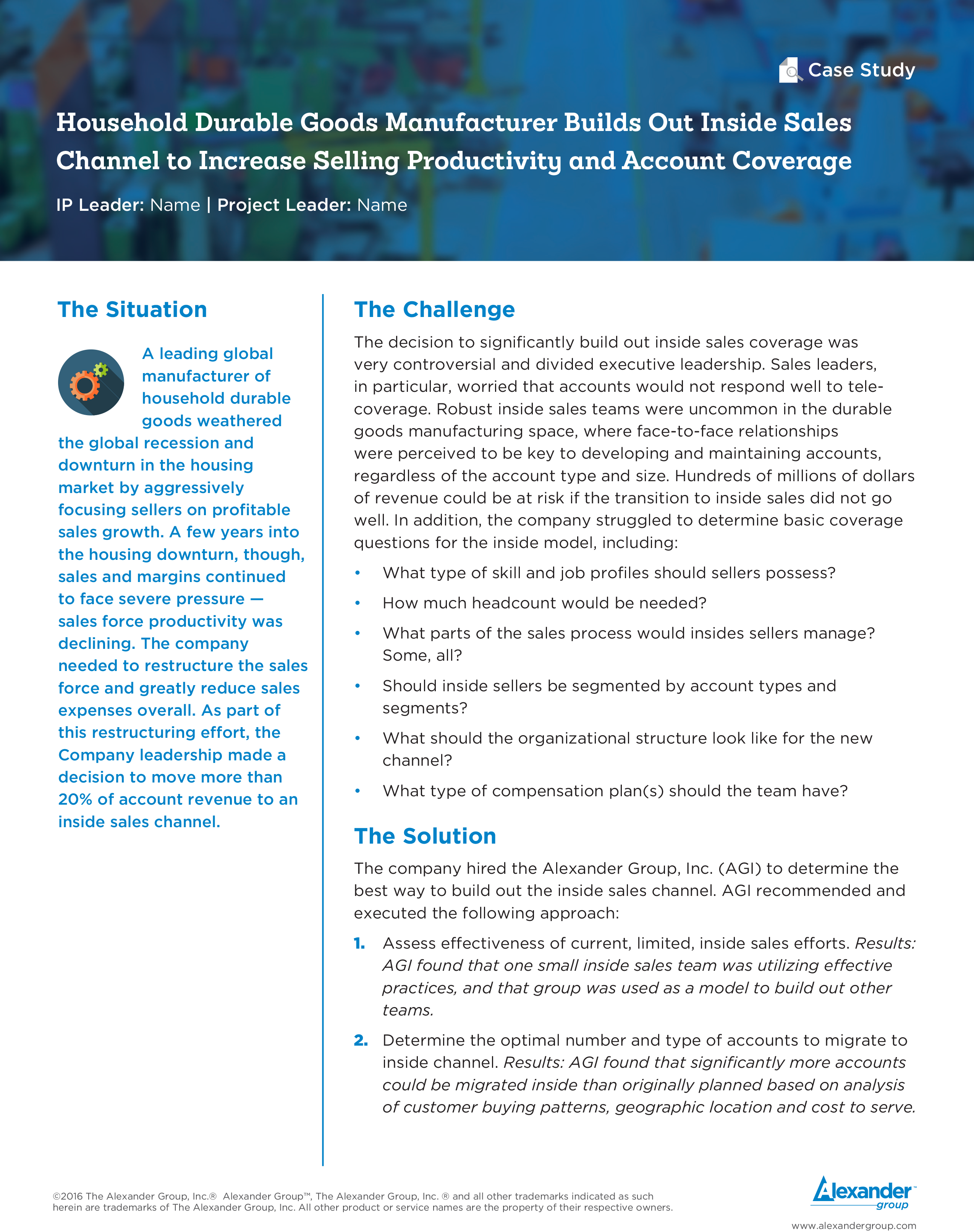Increase Selling Productivity & Account Coverage with Inside Sales
 Situation: A leading global manufacturer of household durable goods weathered the global recession and downturn in the housing market by aggressively focusing sellers on profitable sales growth. A few years into the housing downturn, though, sales and margins continued to face severe pressure — sales force productivity was declining. The company needed to restructure the sales force and greatly reduce sales expenses overall. As part of this restructuring effort, the Company leadership made a decision to move more than 20% of account revenue to an inside sales channel.
Situation: A leading global manufacturer of household durable goods weathered the global recession and downturn in the housing market by aggressively focusing sellers on profitable sales growth. A few years into the housing downturn, though, sales and margins continued to face severe pressure — sales force productivity was declining. The company needed to restructure the sales force and greatly reduce sales expenses overall. As part of this restructuring effort, the Company leadership made a decision to move more than 20% of account revenue to an inside sales channel.
Challenge: The decision to significantly build out inside sales coverage was very controversial and divided executive leadership. Sales leaders, in particular, worried that accounts would not respond well to tele-coverage. Robust inside sales teams were uncommon in the durable goods manufacturing space, where face-to-face relationships were perceived to be key to developing and maintaining accounts, regardless of the account type and size. Hundreds of millions of dollars of revenue could be at risk if the transition to inside sales did not go well. In addition, the company struggled to determine basic coverage questions for the inside model, including:
- What type of skill and job profiles should sellers possess?
- How much headcount would be needed?
- What parts of the sales process would insides sellers manage? Some, all?
- Should inside sellers be segmented by account types and segments?
- What should the organizational structure look like for the new channel?
- What type of compensation plan(s) should the team have?
Solution: The company hired AGI to determine the best way to build out the inside sales channel. AGI recommended and executed the following approach:
- Assess effectiveness of current, limited, inside sales efforts. Results: AGI found that one small inside sales team was utilizing effective practices, and that group was used as a model to build out other teams.
- Determine the optimal number and type of accounts to migrate to inside channel.
Results: AGI found that significantly more accounts could be migrated inside than originally planned based on analysis of customer buying patterns, geographic location and cost to serve. - Design roles, rules of engagement and organization structure. Results: Three distinct roles (Generalist Rep, Key Account Rep and Teamed Rep) were created and assigned across five distinct customer segments.
- Determine headcounts and develop change communication plan. Results: AGI developed a work model showing that several thousand accounts were too small to service even with the inside sales channel. Those accounts were moved to a service channel, greatly reducing the headcount needed to cover remaining accounts. A change roadmap was created and approved by the Steering Team.
Benefit: The company implemented the AGI recommendations over a two-month period and results greatly exceeded expectations. Accounts that transitioned to the inside actually began to outperform field-based accounts in terms of revenue growth. The overall cost to serve accounts was dramatically reduced as outside reps were now able to cover higher volume accounts. Inside reps also became more productive through more balanced account loads, clearer job roles and focused account segment coverage.